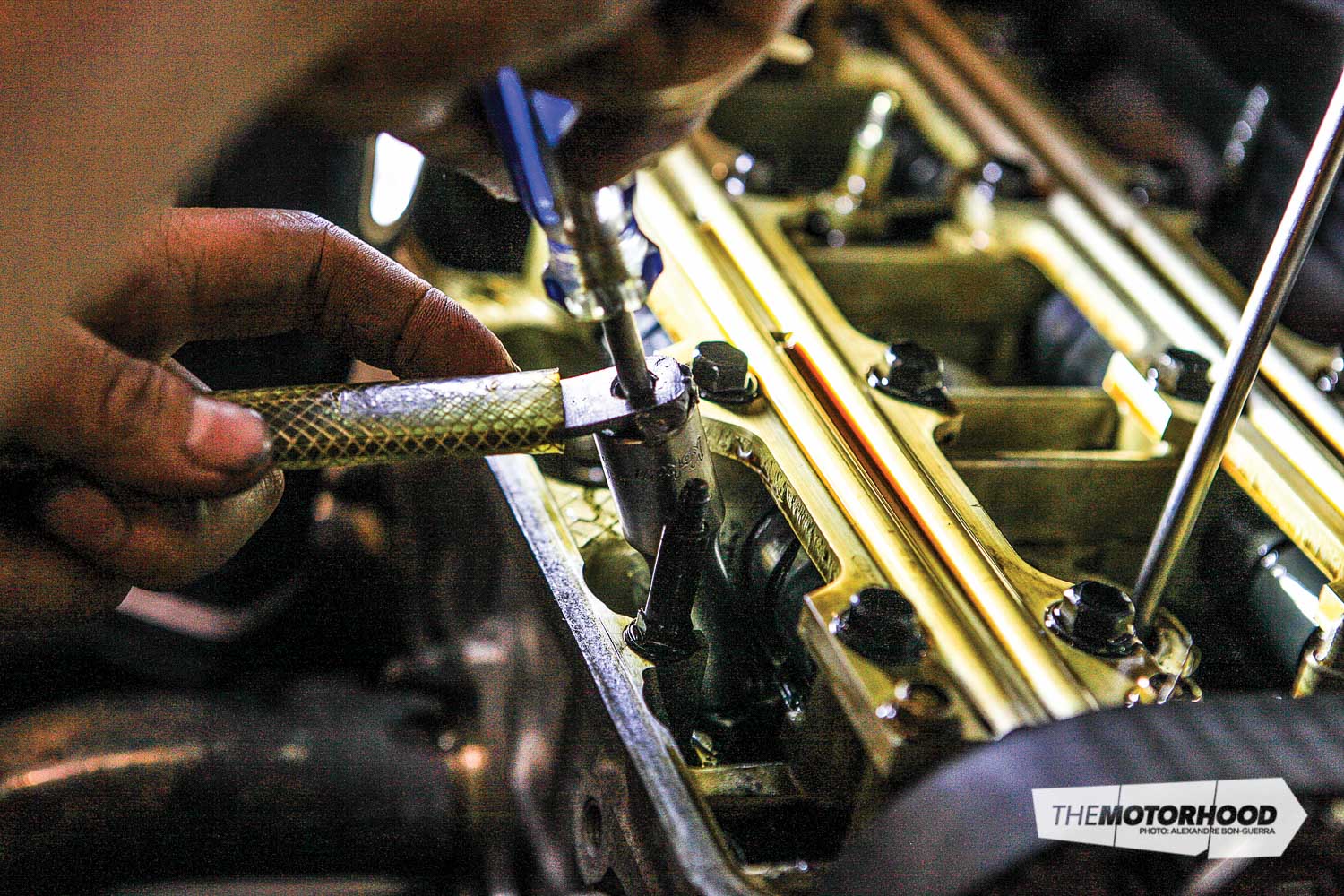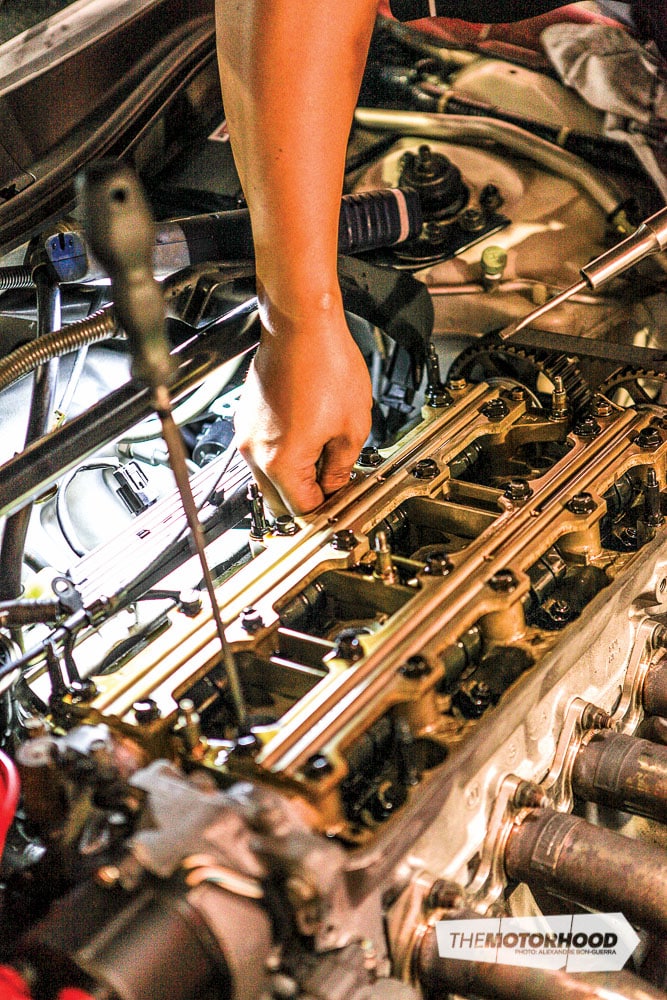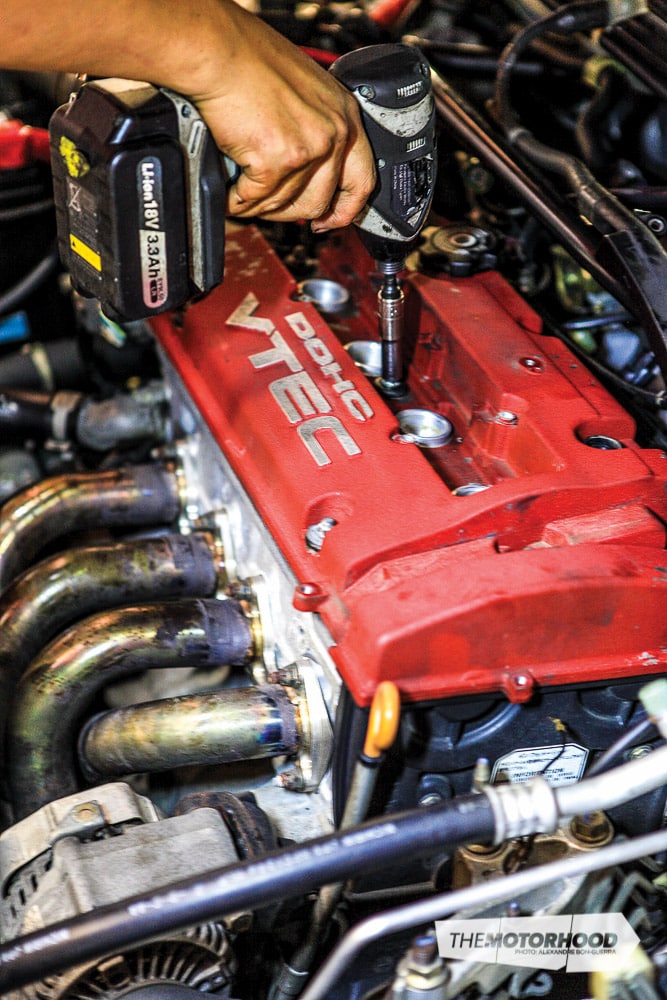If you own an H22A-powered Honda, you’re probably familiar with the ticking noises they’re well known for. The habit is not only very irritating and loud; it’s a sign that your valve clearances are a whisker out, which can lead to reduced fuel consumption, a lower power output, and prematurely worn cam lobes. We teamed up with Jtune Engineering to show you how to fix the issue in less than two hours .
Tools required
• 10mm socket
• Ratchet
• Extensions (at least 400 millimetres’ worth)
• Spark-plug socket (21mm)
• Long screwdriver or narrow stick (around 350mm)
• Feeler gauge that’s correct for your application
• Silicone sealant
• Special Honda valve-adjustment tool (Jtune’s example is made from an old 10-millimetre-deep socket, a welded-on lever, and a piece of pipe as the handle. Make sure there’s a hole down the centre big enough for a screwdriver to go through)

Step one: preparation
Before you begin this task, ensure that the engine is completely cool, as the tolerances adjusted within this guide are affected by heat. For this feature, we allowed up to six hours for the engine to cool right down.

Step two: disassembly
Begin by removing the spark plugs and leads. The spark plugs are removed so that you can easily figure out when the piston you’re working on is at its highest point. This is important, because the valve adjustment cannot be done at any other stage in the engine’s four-stroke cycle.
Once the plugs have been removed, unbolt the rocker cover, associated cabling going over the rocker cover, and positive-crankcase-ventilation (PCV) valve hoses. Ensure you don’t lose the rubber grommets used to hold the rocker cover down, and take this as a chance to check the condition of your spark plugs. Starting on the cylinder furthest from the distributor, place your long screwdriver into the spark-plug hole, so that it sits on top of the piston.

Step three: finding TDC
Get a friend to jump into the driver’s seat, turn the key over to accessory so as to avoid the steering lock, and turn the wheel left hand-down, all the way. This will give you access to the crank-pulley bolt, which we’ll use to turn the engine over until the piston you’re working on is at top dead centre (TDC, the highest point of the stroke), using your ratchet and range of extensions to clear the tyre. As you turn the engine over, watch the screwdriver sitting atop the piston rise and fall. Stop when it’s at its highest.

It will reach this point twice within the four-stroke cylce so you will need to check that both the cam lobes are facing directly upwards, meaning that both valves are closed. This is the position the lobe needs to be in to make the valve adjustment.

Step four: valve adjustment — exhaust
Now that you’re ready to adjust your valves, arm yourself with your special valve-adjustment tool, a flathead screwdriver, and a feeler gauge. To begin, loosen the nut that sits on top of the valve with your special valve-adjustment tool. Start on the exhaust side to ensure consistency.
Once the nut is loose, slide your feeler gauge between the base of the cam and the rocker, the aim being 0.008mm, as this is spec for a H22A engine. We found our measurement was as big as 0.010, which is too large. To get a correct measurement with a feeler gauge, the gauge needs to slide in and out with a slight resistance: if there’s no resistance, it’s too loose, and, if it doesn’t move, it’s too tight. To tighten up the measurement, insert your flathead screwdriver through your valve-adjustment tool, and adjust the screw that sits within the nut. Be careful, though, as when you tighten to the right measurement, you must firmly hold the screw in place with your screwdriver. If you aren’t careful with this, tightening the nut can loosen the screw, bringing you back to square one. Once the nut is tight, check your clearances to ensure they’re still 0.008mm.

Step five: valve adjustment — intake
Once you’ve completed the exhaust side for cylinder four, move onto the intake side. Doing it this way ensures that you will work on one cylinder at a time, rather than crossing over to cylinder two or whichever cylinder is at TDC, which can lead to confusion. The intake side measurement should be set to 0.006mm. Why smaller than the exhaust side? As the exhaust side gets hotter, the tolerances used need to allow for thermal expansion.

Step six: reassembly
Once you’ve completed cylinder four, make your way onto cylinder three, then two, then one. You’ll need to rotate your crank pulley for each one, ensuring the cylinder that you’re working on is at TDC. Once you’ve completed your valve adjustments to spec, reassemble everything you’ve pulled apart to get the job done. Before the rocker cover goes on, check the condition of the gasket. If it’s rock hard, it needs replacing. If the rubber is still good, a simple bead of silicone on each corner is all that will be required. Let the silicone dry for an hour or so, then fire the engine up and listen for any strange noises. Depending on how badly your valve adjustment was out, you should notice an audible difference and feel a slight improvement in both power output and fuel economy.
This article originally appeared in NZ Performance Car Issue No, 231. You can pick up a print copy or a digital copy of the magazine below:





